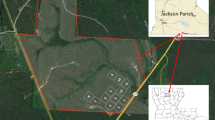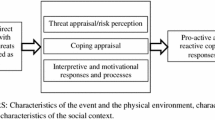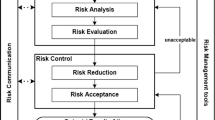Abstract
This paper deals with the forest owner’s attitude towards risk and the harvesting decision in several ways. First, we propose to characterize and quantify the forest owner’s attitude towards risk. Second, we analyze the determinants of the forest owner’s risk attitude. Finally, we determine the impact of the forest owner’s risk attitude on the harvesting decision. The French forest owner’s risk attitude is tackled by implementing a questionnaire, including a context-free measure borrowed from experimental economics. The determinants of the forest owner’s risk attitude and harvesting decision are estimated through a recursive bivariate ordered probit model. We show that French forest owners are characterized by a relative risk aversion coefficient close to 1 with a DARA assumption. In addition, we find that the forest owner’s risk aversion is influenced positively and significantly by the level of risk exposure, the geographical location of the forest and the fact to be a forester, and negatively by the income. Finally, we obtain that the forest owner’s risk aversion has a positive and significant impact on the harvesting decision.
Similar content being viewed by others
Notes
Due to the lack of data on market risk, we rather focus in this paper on production risk.
Gestion ASsistée des Procédures Administratives relatives aux Risques naturels et technologiques: http://macommune.prim.net/gaspar/.
Under €6,000; from €6,000 to €12,000; from €12,000 to €18,000; from €18,000 to €25,000; from €25,000 to €35,000; from€ 35,000 to €50,000; from €50,000 to €100,000; and over €100,000.
The estimation is done using Matlab, the codes are available from the authors upon request.
Regarding the measure of risk aversion, it is not possible to use the empirical counterpart of the latent variable in the harvesting equation. Indeed, it implies eight parameters to estimate in the case of nine classes of risk, which leads to an identification problem because of the lack of data.
More precisely, 16 forest owners do not answer to the question on income, explaining the number of 308 observations in Table 3.
The empirical distribution among the 7 classes of risk is the following: 43.2% for RA5, 19.1% for RA4, 10.5% for RA3, 5.9% for RA2, 4% for RA1, 8.7% for RN, 8.6% for RP.
All the results are available from the authors upon request.
For example, after the storm Klaus in 2009, the French government provided €415 million for an 8-year program in order to salvage and restore forest stands. The level of the financial support depended on the replanted species and was approximately €2750/ha on average [18].
References
Abildtrup, J., Delacote, P., Garcia, S., Lambini, C., & Stenger, A. (2012). A forest owner survey instrument and interview guide ready for implementation. Deliverable D3.2 of the NEWFOREX research project.
Agreste (2014). Enquête sur la structure de la forêt privée en 2012. Chiffres et données. 222.
Alvarez, L., & Koskela, E. (2006). Does risk aversion accelerate optimal forest rotation under uncertainty? Journal of Forest Economics, 12, 171–184.
Andersson, M. (2012). Assessing non-industrial private forest owners’ attitudes to risk: Do owner and property characteristics matter? Journal of Forest Economics, 18, 3–13.
Andersson, M., & Gong, P. (2010). Risk preferences, risk perceptions and timber harvest decisions - an empirical study of nonindustrial private forest owners in northern Sweden. Forest Policy and Economics, 12, 330–339.
Arrow, K. (1970). Essays in the theory of risk-bearing. North-Holland.
Azevedo, C., Herriges, J., & Kling, C. (2003). Combining revealed and stated preferences: consistency tests and their interpretation. American Journal of Agricultural Economics, 85(3), 525–537.
Battalio, R., Kagel, J., & Jiranyakul, K. (1990). Testing between alternative models of choice under uncertainty: some initial results. Journal of Risk and Uncertainty, 3(1), 25–50.
Beattie, J., & Loomes, G. (1997). The impact of incentives upon risky choice experiments. Journal of Risk and Uncertainty, 14, 155–168.
Binswanger, H. (1982). Empirical estimation and use of risk preferences: discussion. American Journal of Agricultural Economics, 64, 391–393.
Birot, Y., & Gollier, C. (2001). Risk assessment, management and sharing in forestry, with special emphasis on wind storms. Paper presented at the 14th convocation of Academies of Engineering and Technological Sciences, Espoo, Finland.
Bontems, P., & Thomas, A. (2000). Information value and risk premium in agricultural production: the case of split nitrogen application for corn. American Journal of Agricultural Economics, 82, 59–70.
Bougherara, D., Gassmann, X., & Piet, L. (2011). Eliciting risk preferences: a field experiment on a sample of french farmers Paper presented at the EAAE 2011 International Congress, Zurich, Switzerland.
Brunette, M., Cabantous, L., Couture, S., & Stenger, A. (2009). Assurance, intervention publique et ambiguïté: une étude expérimentale auprès de propriétaires vés . Économie et Prévision, 190-191(4-5), 123–134.
Brunette, M., Cabantous, L., Couture, S., & Stenger, A. (2013). The impact of governmental assistance on insurance demand under ambiguity : a theoretical model and an experimental test. Theory and Decision, 75, 153–174.
Brunette, M., & Couture, S. (2017). Is forest insurance a relevant vector to induce adaptation efforts to climate change? Forthcoming in Annals of Forest Science.
Brunette, M., Couture, S., & Laye, J. (2015). Optimizing forest management under storm risk with Markov decision process model. Journal of Environmental Economics and Policy, 4(2), 141–163.
Brunette, M., Holecy, J., Sedliak, M., Tucek, J., & Hanewinkel, M. (2015). An actuarial model of forest insurance against multiple natural hazards in fir (abies alba mill.) stands in Slovakia. Forest Policy and Economics, 55, 46–57.
Cameron, A. C., & Trivedi, P.K. (2010). Microeconometrics Using Stata, Revised Edition. Rev. ed. College Station: Stata Press.
Clarke, H., & Reed, W. (1989). The trre-cutting problem in a stochastic environment: the case of age-dependent growth. Journal of Economic Dynamics and Controls, 13, 569–595.
Conway, C., Amacher, G., Sullivan, S., & Wear, D. (2003). Decisions non-industrial forest landowners make: an empirical examination. Journal of Forest Economics, 9(3), 181– 203.
Couture, S., & Reynaud, A. (2008). Multi-stand forest management under a climatic risk: do time and risk preferences matter? Environmental Modelling and Assessment, 13, 181–193.
Cox, J., & Harrison, G. (2008). Risk aversion in experiments, (p. 12). Bingley: Emerald, Research in Experimental Economics.
Darses, O., Garcia, S., & Stenger, A. (2012). Drivers of cooperation for private and public goods provision: evidence from a national survey on french private forest owners. Paper presented at the annual congress of the European Association of Environmental and Resource Economists, Prague.
Davidson, R., & MacKinnon, J. (1993). Eliciting risk preferences: when is simple better? Estimation and inference in econometrics. Oxford University Press.
Dennis, D. F. (1990). A probit analysis of the harvest decision using pooled time-series and cross-sectional data. Journal of Environmental Economics and Management, 18(2), 176–187.
Eckel, C., & Grossman, P. (2008). Forecasting risk attitudes: an experimental study using actual and forecast gamble choices. Journal of Economic Behavior and Organization, 68(1), 1– 7.
Eswaran, M., & Kotwal, A. (1990). Implications of credit constraints for risk behaviour in less developed economies. Oxford Economic Papers, 42, 473–482.
Fuhrer, J., Beniston, M., Fischlin, A., Frei, C., Goyette, S., Jasper, K., & Pfister, C. (2006). Climate risks and their impact on agriculture and forests in Switzerland. Climatic Change, 79, 79–102.
Galarza, F. (2009). Choices under risk in rural Peru. Working Paper MPRA, 17708, 54.
Garcia, S., Kéré, N. E., & Stenger, A. (2014). Econometric analysis of social interactions in the production decisions of private forest owners. European Review of Agricultural Economics, 41(2), 177–198.
Gollier, C. (2001). The economics of risk and time. Cambridge: The MIT Press.
Gong, P., & Löfgren, K. (2003). Risk-aversion and the short-run supply of timber. Forest Science, 49(5), 647–656.
Guiso, L., & Paiella, M. (2006). The role of risk aversion in predicting individual behavior. In Chiappori, P. A., & Gollier, C. (Eds.), Insurance: theoretical analysis and policy implications. Cambridge: MIT Press.
Hershey, J., & Schoemaker, P. (1990). Risk taking and problem context in the domain of losses: an expected utility analysis. Journal of Risk and Insurance, 47(1), 111–132.
Holt, C., & Laury, S. (2002). Risk aversion and incentive effects. The American Economic Review, 92(5), 1644–1655.
Hyberg, B., & Holthausen, D. (1989). The behavior of nonindustrial private forest owners. Canadian Journal of Forest Research, 15, 1014–1023.
IGN (2012). La forêt en chiffres et en cartes. Institut national de l’information géographique et forestière.
Kangas, J. (1994). Incorporating risk attitude into comparison of reforestation alternatives. Scandinavian Journal of Forest Research, 9, 297–304.
Koskela, E. (1989). Forest taxation and timber supply under price uncertainty: perfect capital markets. Forest Science, 35, 137–159.
Lidestav, G., & Ekström, M. (2000). Introducing gender in studies on management behaviour among non-industrial private forest owners. Scandinavian Journal of Forest Research, 15(3), 378–386.
Lien, G., Størdal, S, & Baardsen, S (2007). Technical efficiency in timber production and effects of other income sources. Small-scale Forestry, 6(1), 12.
Lien, G., Størdal, S., Hardaker, J, & Asheim, L (2007). Risk aversion and optimal forest replanting: a stochastic efficiency study. European Journal of Operational Research, 181, 1584–1592.
Lobianco, A., Delacote, P., Caurla, S., & Barkaoui, A. (2015). Accounting for active management and risk attitude in forest sector models: an impact study on french forests. Environmental Modeling and Assessment, doi:10.1007/s10666-015-9483-1.
Lönnstedt, L., & Svensson, J. (2000). Non-industrial private forest owner’s risk preferences. Scandinavian Journal of Forest Research, 15(6), 651–660.
Musshof, O., & Maart-Noelck, S. (2014). An experimental analysis of the behavior of forestry decision-makers - the example of timing in sales decisions. Forest Policy and Economics, 41, 31–39.
Petucco, C., Abildtrup, J., & Stenger, A. (2015). Influences of nonindustrial private forest landowners’ management priorities on the timber harvest decision—a case study in France. Journal of Forest Economics, 21(3), 152–166.
Provencher, B. (1997). Structural versus reduced-form estimation of optimal stopping problems. American Journal of Agricultural Economics, 79(2), 357–368.
Reynaud, A., & Couture, S. (2012). Stability of risk preference measures: results from a field experiment on french farmers. Theory and Decision, 73, 203–221.
Sajaia, Z. (2008). Maximum likelihood estimation of a bivariate ordered probit model: implementation and monte carlo simulations. The Stata Journal, 4, 282–289.
Sauter, P., Musshoff, O., Mohring, B., & Wilhelm, S. (2016). Faustmann vs. real options theory - an experimental investigation of foresters’ harvesting decisions. Journal of Forest Economics, 24, 1–20.
Schelhaas, M., Nabuurs, G., & Schuck, A. (2003). Natural disturbances in the european forests in the 19th and 20th centuries. Global Change Biology, 9, 1620–1633.
Spittlehouse, D., & Stewart, R. (2003). Adaptation to climate change in forest management. BC Journal of Ecosystems Management, 4, 1–11.
Størdal, S., Lien, G., & Baardsen, S (2008). Analyzing determinants of forest owners’ decision-making using a sample selection framework. Journal of Forest Economics, 14, 159–176.
Thürig, E., Palosuo, T., Bucher, J., & Kaufmann, E. (2005). The impact of windthrow on carbon sequestration in Switzerland: a model-based assessment. Forest Ecology and Management, 210, 337–350.
Uusivuori, J. (2002). Non-constant risk attitudes and timber harvesting. Forest Science, 48, 459–470.
Greene, W.H., & David A.H. (2010). Modeling ordered choices: a primer. Cambridge University Press.
Wik, M., Kebede, T., Bergland, O., & Holden, S. (2004). On the measurement of risk aversion from experimental data. Applied Economics, 36(21), 2443–2451.
Williams, D., & Liebhold, A. (1995). Herbivorous insects and global change: potential changes in the spatial distribution of forest defoliator outbreaks. Journal of Biogeography, 22, 665–671.
Acknowledgments
We are grateful to the European project Newforex, the National Institute of Geographic and Forest Information (IGN), and Région Lorraine that funded the survey. The UMR Economie Forestière is supported by a grant overseen by the French National Research Agency (ANR) as part of the “Investissements d’Avenir” program (ANR-11-LABX-0002-01, Lab of Excellence ARBRE). Finally, this work has benefited from the support of the Agence Nationale de la Recherche of the French government, through the program “Investissements d’avenir” (ANR-10-LABX-14-01).
Author information
Authors and Affiliations
Corresponding author
Appendix: Maximum likelihood estimation
Appendix: Maximum likelihood estimation
Following Sajaia [50], we show that the probability that y 1i = j and y 2i = 1 or 0:
and
The system of Eq. 1 can be estimated by the maximum likelihood method. Indeed, we assume that (𝜖 1i ,𝜖 2i ) ∼ N(0, Ω) with \( {\Omega }= \left (\begin {array}{cc} 1 & \rho \\ \rho & 1 \end {array} \right )\); thus, we get:
Given that \( \left (\begin {array}{cc} \!1\! & \!0\! \\ \!\gamma \! & \!1\! \end {array} \right ) \left (\begin {array}{c} \!\epsilon _{1i\!} \\ \!\epsilon _{2i}\! \end {array} \right )\!\!\! \sim \!\! N\! \left (0, \left [ \begin {array}{cc} 1 & \gamma \,+\, \rho \\ \gamma \,+\, \rho & \gamma ^{2} \,+\, 2 \gamma \rho \,+\, 1 \end {array} \right ] \right )\) we have:
Similarly, we obtain:
with \(\tilde {\rho } = \gamma + \rho \), ζ = (γ 2 + 2γρ + 1)−1/2 and Φ and Φ2 the univariate and bivariate standard cumulative distribution functions, respectively. If j = 1, then the probabilities above shrink to:
If j = J, then the probabilities above shrink to:
If we assume that the observations are independent, the log-likelihood function can be written as follows:
The maximum weighted likelihood estimator can be written as:
where w is the weighting vector.
Rights and permissions
About this article
Cite this article
Brunette, M., Foncel, J. & Kéré, E. Attitude Towards Risk and Production Decision: an Empirical Analysis on French Private Forest Owners. Environ Model Assess 22, 563–576 (2017). https://doi.org/10.1007/s10666-017-9570-6
Received:
Accepted:
Published:
Issue Date:
DOI: https://doi.org/10.1007/s10666-017-9570-6




